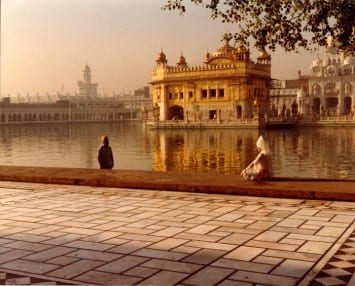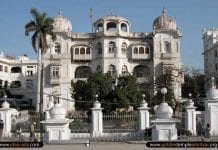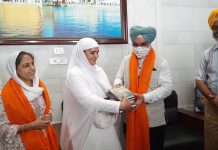


Thirty years have elapsed since the Indian Army attacked Akal Takht and Darbar Harmandir Sahib (Golden Temple) of Amritsar during the first week of June week in 1984. The wounds of the tragedy are still fresh, as is the anguish and pain that persists in the collective Sikh consciousness.
The impact was evidenced in the recently concluded parliamentary elections. Arun Jaitley, a heavy weight leader of the Bharatiya Janata Party (BJP) which had supported the Army attack, received a drubbing in the Amritsar constituency at the hands of Amrinder Singh of Congress, who had resigned from the party and from his membership of Indian Parliament in protest against the Army entry into the Sikh shrine. Otherwise, the BJP, riding the Modi wave staged a spectacular victory, mauling the Congress, a leader of the ruling Unlawful Activities Prevention Act (UAPA /UPA) alliance for 10 years, to a political insignificance. The Amritsar Lok Sabha seat has a 65 per cent Sikh population.
The Sikh intelligentsia, gathered while observing the [3o year] anniversary at Chandigarh on June first (2014) expressed resentment over the fact that even today there has still been no official, authentic information made available as to how many civilians were killed, maimed, and suffered in that tragic attack [of premeditated Sikh genocide], codenamed by the Army as ‘Operation Blue Star’.



Only the barest details of Army parlance regarding numbers of those who were detained in the Jodhpur jail, and those ‘captured as ‘POWs’ (prisoners of war) from the Golden Temple complex were made available. But, there are numerous estimates about the probable number including women, and children of those killed, wounded, and taken into custody from within Darbar Sahib, (a reverential Sikh name for the Golden Temple Complex) and from other parts of Punjab. And, there is no accurate report of the substantial civil death toll as the Army simultaneously stormed 42 gurdwaras (Sikh shrines) in various parts of Punjab along with the main assault in Amritsar, that was mounted to catch Sant Jarnail Singh Bhinderanwale, and his estimated 200 armed followers, dead or alive. The Sikhs are nowhere closer to understanding, but are still piecing together the events of that cataclysmic period in order to arrive at the total extent of human rights violations involving the sufferings of thousands of innocents.
Until today, many queries of the Sikhs remained unanswered such as:
- What level of planning went into the Army attack spread over entire Indian Punjab?
- What was political expediency behind the mounting of a full-scale-war on the Sikhs and their religious places?
- Why did the Army choose the fifth Sikh Guru Arjun Dev’s martyrdom day for the attack, when thousands of pilgrims are known to throng the Golden Temple?
- Who, besides the political sanction from the top, were involved in making key decisions regarding the planning and execution at various official levels up to, and during the operation?
- Does the official nonchalant attitude amount to the denial of equal citizen rights to Sikhs?
It may be far-fetched to many, however by Sikhs the resemblance is noticed between the Sikh tragedy of 1984, and that of the Partition of 1947 which took toll of one million human lives during the world’s unparalleled violent exchange of a population of 14 million people with no official acknowledgement up until today, from either the Indian and Pakistani sides, as to what exactly happened then.
The only official document available on the Amritsar mayhem up until day is the White Paper, issued just after the Army attack on July 10, 1984. The White Paper was a hurriedly undertaken official exercise meant to suppress, and hide, the colossal loss of life and property that resulted from the operation which was planned as a ‘precise and quick surgical-type military action’ without anticipating the fierce resistance to the Army attack from devout Sikhs, who, following the 300 year old tradition, laid down their lives to preserve the sanctity of the Sikhs’ Sanctum Sanctorum. Also, the White Paper was more of a public relation exercise, perfectly in tune with the pre-operation official disinformation campaign which arose out of the political expediency of the ruling Congress to justify and project the ‘operation’ as ‘ clean and unavoidable’ to the vast Indian majority. Moreover, the Paper was also aimed at thwarting unsavory and negative propaganda unleashed by the Operation throughout the world which raised questions as to ‘why the Indian Army was used on own citizens?’ And, to some extent it was directed towards mollifying the ruffled feelings of those Sikhs siding with the Indian establishment who, too, had felt extremely hurt and religiously injured by the attack on the Golden Temple which is the ‘Mecca’ of the Sikhs.
Against this background, the Sikhs and the most of well-meaning Indian people including human and civil Rights activists, have never believed the information given out in the White Paper, but have continuously demanded that the government come out with what actually happened during that their Operation. For instance, the While Paper gave the number of soldiers and officers killed as 83, and 249 injured. Former Prime Minister Rajiv Gandhi, later, stated that upwards of 700 army personnel had been slain. Refuting the figure released by the White Paper regarding the number of casualties of civilians which resulted from the Operation, late eminent writer Khushwant Singh wrote in his book, the first to be published towards the end of 1984,
There can be little doubt that if a zero were to be added to the official figure of 516 civilian / terrorist casualties, we would be closer to the actual number of lost lives—- it was certainly in the vicinity of 5000 dead.
The White Paper underlined that ‘’ 592 civilians / terrorists” were apprehended from the Golden Temple Complex.
It was an open secret, that in the sweltering heat of the month of June, the rotting corpses of hundreds of the Sikhs killed inside the Golden Temple Complex were not taken for mandatory post-mortem. Instead those stinking bodies were heaped up into the garbage trucks of the municipal committee by inebriated sweepers bribed by the authorities for doing that arduous job and the trucks with human limbs protruding through broken sheets, which emanating their foul smell passed through the city streets— in full public view— to the nearby cremation ground for quick disposal. Postmortem was conducted on the bodies of some Sikh youths by a team of doctors brought from Jalandhar (a Punjab city) who registered in their reports that the hands of some Sikh youths were tied behind their back with their turbans and then shot dead point blank. However most of the bodies were disposed of in lots as unidentified, with or without a postmortem exercise.
The inmates in the Complex who were treated as ‘enemies’ violated international war conventions. Red Cross people were not allowed to enter even after the operation was over. Their volunteers were detained a kilometer away from the venue of casualties. Several witnesses affirmed that there were at least 10,000 people inside the Temple Complex including 4000 women, youths, and young children. An Akali Dal jatha (the party volunteers) of 1300 workers from Sangrur district including 200 women and 18 children were inside the Complex courting arrest the next day. Several pilgrims came to the Complex on June 3rd to pay their obeisance for Guru Arjun Dev martyrdom day. But all those inside the Temple Complex were not allowed to go out after 10. PM on June 3.
Even the authentic list of the 4000 Sikh soldiers, who had left their barracks and marched towards Amritsar, being unable bear the religious injury and shock following the Army attack on Durbar Sahib, a sacred shrine of their faith, has not been officially released up till today. And there is no information about how many Sikhs, who rushed towards Amritsar from various parts of curfew-bound Punjab following the Army attack, were killed, injured, and detained. Nor how many milk vendors bringing milk to the city were killed, or detained nor how many buffaloes died during the Amritsar city curfew that spanned several days. Similarly, there was no actual information about how many were killed, injured, or detained in the Army attacks on 42 gurdwaras (Sikh shrines) in Punjab particularly at Patiala, Moga, Mukatsar, and Tarn Taran urban areas. For example, there were many incidences of inhuman and cruel excesses perpetrated on the Sikhs which were out of sync with a democratic polity and civilized society.[edited to here]
Overzealous authorities picked up 21 boys between the age of 4 and 12 from the Golden Temple complex during the Operation and sent them to the Ludhiana jail listing them under three categories of terrorists:
- Very dangerous
- Dangerous
- Potentially dangerous
They were transferred to Amritsar following a writ of ‘habeas corpus’ moved in Supreme Court at that time on their behalf by Smt. Kamal Devi Chattopadhyaya.
The Sikh Reference library housing rare hand-written copies of Granth Sahib (Sikh scripture) and Hukamnama (edicts) were burnt. According to the recorded statements of many witnesses, including archivist in-charge late Devinder Singh Duggal, and the SGPC, the archives were set on fire after the Army operation was over. But the White Paper maintained that the library building caught fire during the exchange of gunfire.
The “Citizens For Democracy’ brought out Report to the Nation with Foreword by the eminent human and civil rights champion of that time, Justice V.M Tarkunde and Preface by George Fenandes, later to become the Defence Minister of the country. The publication carried interviews of several witnesses who revealed the gory details of inhuman excess. The facts, laid out in a report, titled Oppression in Punjab were never contested by New Delhi, instead, the authorities chose to ban the book which was published towards the end of 1985.
The Massacre of Jallianwala Bagh, located adjacent to the Golden Temple Complex occurred in 1919 when India was a British colony and Indians were struggling to get freedom from the foreign yoke. It occurred about 65 odd years before the ‘Operation Blue Star’ genocide. Both tragedies took place at the same locale in Amritsar, though at different times and under political dispensations, bear a striking resemblance with the military’s excessive gunfire when shooting innocent citizens without warning. But there is a stark difference between the post-attack treatment given to the victims and action taken against the perpetrators of inhuman cruelty.
In 1919, the horrendous shooting of the people assembled on the Jallianwala Bagh grounds to protest against Rowlett’s Act, as many as 359 people were killed, and 1200 wounded. The dead were identified and their bodies were handed over to the families for last rites, and the wounded were admitted to hospitals and compensated for the treatment.
A Hunter Commission of Inquiry was instituted against the decorated British General Dyer who had ordered the firing of ammunition upon non-combatant people who were under the protection of the Empire. General Dyer was never exonerated for that avoidable human loss and died a disgraced military officer.
On the other hand, the operation ordered by the ‘democratic government of the Free India’ and executed by the Army upon the Golden Temple complex used excessive military might including tanks along the pattern of a country waging war against an ‘alien’ enemy. The democratic Indian state awkwardly missed the point made by the British Empire’s gesture of justice shown to its subjects — who were not even considered to be their citizens — but still instituted a commission inquiry that had probed the Jallainwala Bagh tragedy. Winston Churchill, the British Secretary of War at that time, publicly confessed that General Dyer took ‘an extra-ordinary step’.
But nothing of that sort, not even a single word of consolation has been uttered by the Indian establishment, Parliament concerning their Army attack. The continuing cruel silence over the genocidal massacre leads every sane person to conclude that the government establishment still justifies the operation.
The tragedy of year of 1984 including the November pogrom carried out against the Sikhs in Delhi, and other places, in the aftermath of Indira Gandhi’s assassination, and indifference shown by the Indian establishment thereafter, affirms the views of some intellectuals that ‘the collective assertion of the Sikh minority as being a ‘separate and distinct nation’ is at odds with the Indian Nation building project based on the Hindu religious-cultural ethos as undertaken by Nehru and Patel at the beginning of Free India. And the rising pitch of slogans like ‘ Bharat Mata ki jai’ and ‘Bande Maatrum’ at public rallies of the recently concluded parliamentary polls have clearly reflected that the Hindutva has become stronger, enough so as to publicly vouchsafe that ‘barring the Hindu nationalism, there is no other nationalism’ in India. Minorities should not be under any illusion that the Indian constitutional democracy would prevail upon the defiant march of Hindutva in any manner.
Contextualizing the Sikhs demands for justice for sufferers of the Army attack on the Golden Temple and for those of the November 1984 pogrom, some say, is nothing more than a chimera brooding over what has already happened. In consolation others assert that, ‘the Sikh minority is simply the victim of unfinished agenda of Indian independence’.




